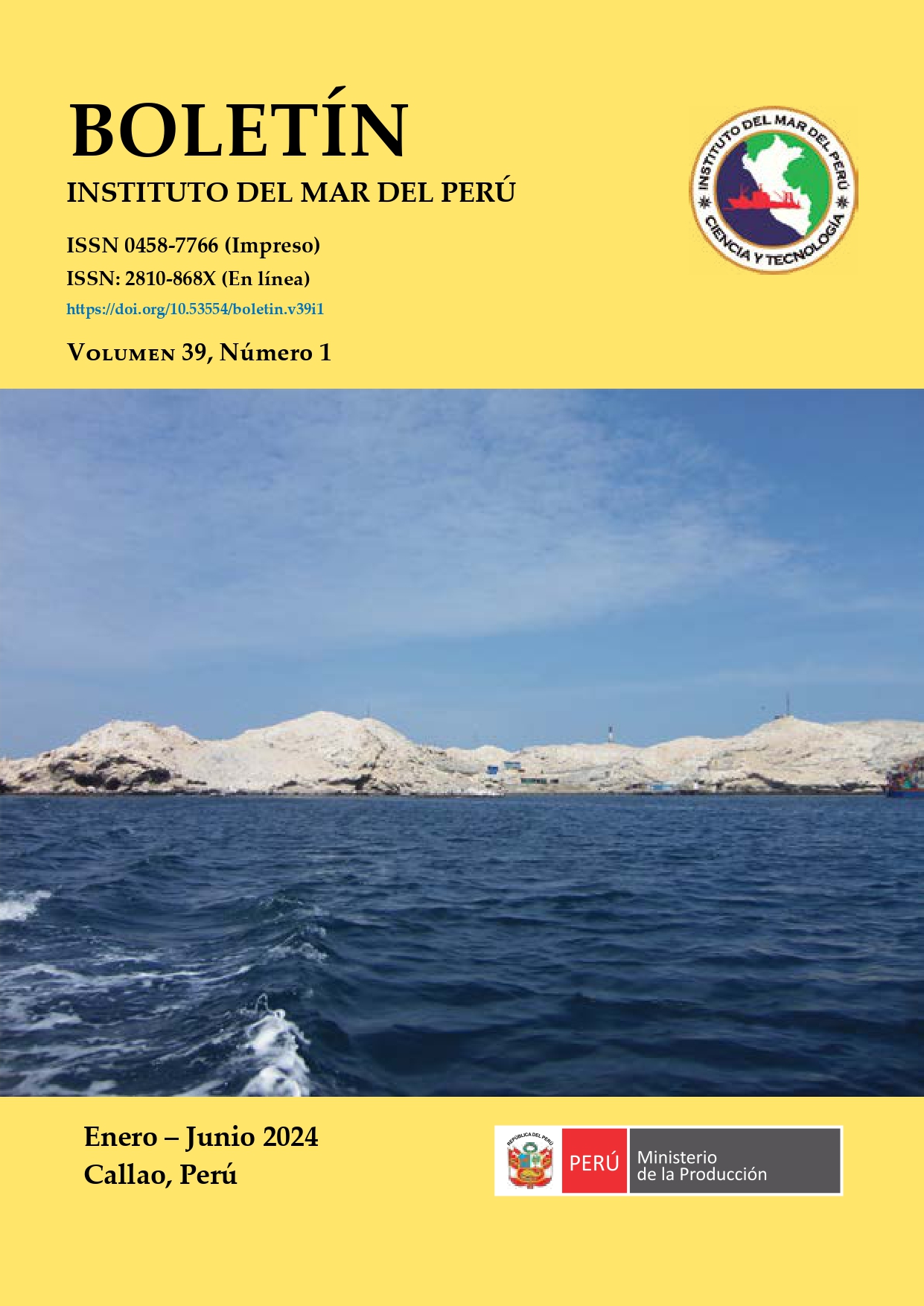Histologically validated gonadal maturity scale of Litopenaeus vannamei (Boone, 1931) females, Peru
DOI:
https://doi.org/10.53554/boletin.v39i1.396Keywords:
Litopenaeus vannamei, Gonadal maturity stages, Histological validation, TumbesAbstract
Litopenaeus vannamei in the Tumbes Region is an economically significant resource. Despite continuous fishing pressure, there is a lack of biological and fishery information. The objective, in order to identify gonadal maturity stages in females, is to develop a macroscopic scale validated histologically. From October 2017 to December 2018, 600 ovaries were collected from the artisanal fisheries in Tumbes, spanning from La Cruz (3°37’19"S - 80°33’19"W) to Grau (3°39’34"S - 80°36’53"W).
These were histologically analyzed using the paraffin infiltration technique. Six gonadal maturity stages were established: virginal (stage 0), resting (stage I), maturing (stage II), mature (stage III), spawning (stage IV), and recovering (stage V), allowing the differentiation between juvenile and adult females, as well as those in recovery. Additionally, five types of sexual cells were identified: four types of oocytes at different developmental stages (immature, previtellogenic, vitellogenic, and mature) and atretic oocytes. With these results, the gonadal maturity stages in female L. vannamei can be easily and precisely distinguished, making it a practical and user-friendly tool in the field.
Downloads
Alternative Metrics
Metrics
References
Alvarado, D. P. (2005). Período reproductivo del camarón café Farfantepenaeus californiensis (Holmes, 1900) en el litoral de Agiampo, Sonora-Sinaloa, México [Tesis de Maestría en Ciencias]. Centro de Investigaciones Biológicas del Noroeste, S. C. http://dspace.cibnor.mx:8080/handle/123456789/95
Buitrón, B., Perea, A., Mori, J., Sánchez, J., Roque, C., Castillo, J. & Gálvez, M. A. (2015). Madurez gonadal de algunos peces de importancia comercial: Escalas macroscópicas validadas microscópicamente. Bol Inst Mar Perú 30(1-2), 3-9. https://hdl.handle.net/20.500.12958/2935
Espinoza, E., Alemán, S., Ramírez, P. & Castillo, G. (2016). Protocolo para muestreo biológico y biométrico de crustáceos marinos. Inf Inst Mar Perú, 43(4), 402-424. https://hdl.handle.net/20.500.12958/3126
Flores, S. A. & Hirt, L. M. (1999). Biología reproductiva de las hembras de Hemiodus orthonops (Eigemann y Kenedy, 1909) (Pisces, Hemiodidae). Boletim do Instituto de Pesca, São Paulo, 25, 111-120. https://institutodepesca.org/index.php/bip/article/view/655
García, S. & Le Reste, L. (1986). Ciclos vitales, dinámica, explotación y ordenación de las poblaciones de camarones peneidos costeros (Documento Técnico de Pesca Nº 203). FAO.
Humason, G. L. (1979). Animal tissue techniques (4º ed.). W. H. Freeman and Company.
Hunter, J. R. & Macewicz, B. J. (1985). Measurement of spawning frequency in multiple spawning fishes. In R. Lasker (Ed.), An egg production method for estimating spawning biomass of pelagic fish: Application to the northern anchovy, Engraulis mordax, (pp. 79-94). NOAA. https://repository.library.noaa.gov/view/noaa/5695
Llanos, J., Inga, C., Ordinola, E. & Rujel, J. (2010). Investigaciones biológico pesqueras en la Región Tumbes, Perú. 1996-2005. Inf Inst Mar Perú, 37(3-4), 95-113. https://repositorio.imarpe.gob.pe/handle/20.500.12958/2007
Méndez, M. (1981). Claves de identificación y distribución de los langostinos y camarones (Crustacea: Decapoda) de mar y ríos de la costa del Perú. Bol Inst Mar Perú, 5(1), 1-170. https://hdl.handle.net/20.500.12958/1028
Ordinola, E., Inga, C. & Alemán, S. (2008). Un estudio sobre langostinos (Penaeoidea) en Caleta La Cruz, Tumbes. Febrero–Junio 2003. Inf Inst Mar Perú, 35(3), 231-240. https://hdl.handle.net/20.500.12958/1973
Peixoto, S., Wasielesky, W. & Cavalli, R. O. (2011). Broodstock maturation and reproduction of the indigenous pink shrimp Farfantepenaeus paulensis in Brazil: An updated review on research and development. Aquaculture, 315(1–2), 9-15. https://doi.org/10.1016/j.aquaculture.2010.04.009
Pérez Ferro, D. G. & Paramo Granados, J. E. (2014). Estadios de madurez del camarón rosado Farfantepenaeus notialis (Penaeidae) en el caribe colombiano. Acta biológica colombiana, 19(2), 185-194. https://doi.org/10.15446/abc.v19n2.39838
Pérez Cerquera, O., Quiroz Mercado, C. & Viacava Campos, M. (1979). Avances en el estudio de la reproducción del langostino (Género Penaeus). Inf Inst Mar Perú, (73), 1-29. https://hdl.handle.net/20.500.12958/298
Ruíz, A. E. & Mendia, L. F. (2008). Observaciones morfométricas y reproductivas en el langostino Pleoticus muelleri Bate, 1888 procedente de embarcaciones comerciales del puerto Rawson, Argentina. Revista de Biología Marina y Oceanografía, 43(3), 675-680. https://www.scielo.cl/pdf/revbiolmar/v43n3/art26.pdf
Scelzo, M. A. (2016). Biología reproductiva del langostino y del camarón de las aguas marinas argentinas. En E. E. Boschi (Ed.), El Mar Argentino y sus recursos pesqueros. Tomo 6: Los crustáceos de interés pesquero y otras especies relevantes en los ecosistemas marinos (pp. 71-88). Instituto Nacional de Investigación y Desarrollo Pesquero. http://hdl.handle.net/1834/14368
Tresierra Aguilar, A. E, Culquichicón Malpica, Z. G. & Veneros Urbina, B. (2002). Biología reproductiva en peces. Nuevo Norte S. A.
West, G. (1990). Methods of assessing ovarian development in fishes: a review. Australian Journal of Marine and Freshwater Research, 41(2), 199–222. https://doi.org/10.1071/MF9900199
Downloads
Published
How to Cite
Issue
Section
License
Copyright (c) 2024 Boletin Instituto del Mar del Perú

This work is licensed under a Creative Commons Attribution-NonCommercial-ShareAlike 4.0 International License.










